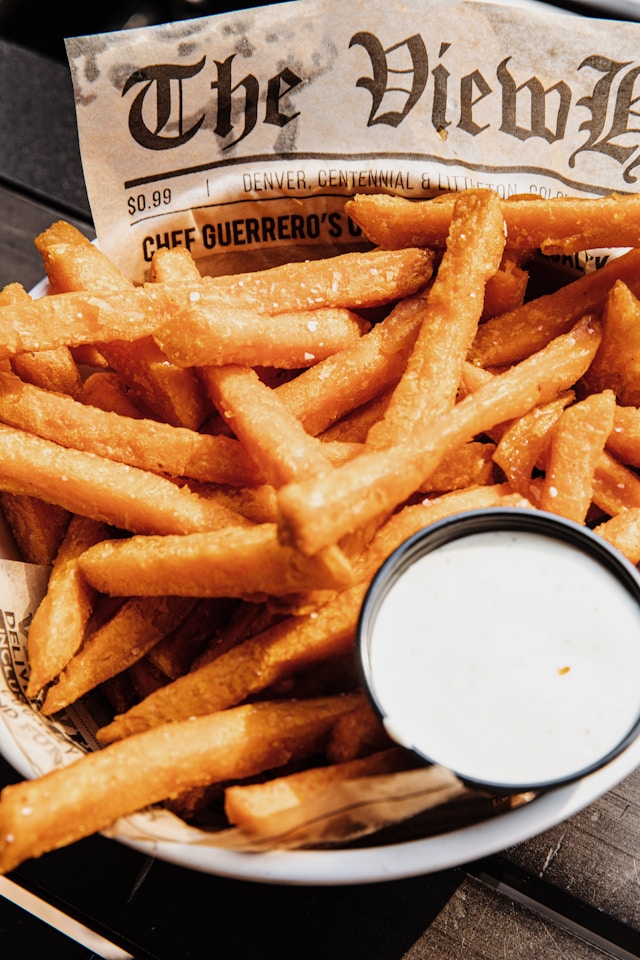Pub grub is synonymous with roasted, salted and battered peanuts, while waiting for sausage and mash, or a steak and ale pie – or if in summer, a packet of crisps while waiting for the fish, gammon or steak that will be served with chips and garnishing of something green. Humble food. British food at its finest. The food that memories are made over in the summer heat, and which have nurtured a frozen soul out of their winter coats.
But looking at the menu’s now, gone are these simple classics, and in are the gastronomical madnesses of Heston Blumenthal. Goodbye pie and mash, and hello Confit Duck leg served with sweet potato, greens, pickled radish , cherry and port jus. It’s a phenomenon taking the British dining scene to a new level of pomposity: seemingly consolidating the stereotypes of Tory poshness, and at the same time donning the traditional pub grub as the foods the cast of “This is England” would dine upon. I would say such movement can be broken down into several phases, under my so called “chip-evolution”, each phase marking some crucial parts of not just our society, but British tastebuds as well.
Bucket of chips
We start at the beginning – the humble bucket of chips. Now I can’t remember what chips looked like before this, but I can certainly remember the ho-ha it caused at the pub table when we read steak and “bucket-of-chips” on the menu. Perhaps the predecessor to the trend of serving things on anything but a plate, the humble bucket took the humble chip and made it centre on the meal (in my opinion rightfully so). In the eyes of 5 year old me, the bucket was huge, making the meal that more spectacle, but that was from the perspective of a tiny child who thought Easter eggs were big.
Yet this bucket trend was realistically a portion controlling measure for Pubs up and down the country, wherein portions could be made smaller and prices higher. Downscaling the Michelle star styles of food styling, where plates the size of mini-moons would present a mouthful of pomposity, these buckets mark the downfall to the humble pub-grub. As as Michelle-Stars start adding up, the plates rims expand, the bucket sizes have decreased: only the other week while at a family dinner I witnessed my brother being given a “bucket” of 10 chips – TEN. The bucket was honestly smaller than those I’ve seen drinks served in.
Tripled cooked chips
The true shift towards gourmand cooking, and one of Heston’s own creation. Meant to make the perfect crispy chip, this style of scientific wizardry turned the humble chip into a marker of a good pub. Here on in, pubs had a standard to be met, and that could be judged by their chip. What’s more, if their chips – the simplest item on the menu – had now become extravagant, it meant everything else had to be upgraded to a whole new level. The steak couldn’t just be good, it had to served with about 30 different homemade sauces. Made blue, rare, medium-rare, medium-rare plus, medium, medium-well done, well done, smoked, sautéed, dry roasted. All because the chips were now better.
What more, by marking a transition on the cooking styles, to make something “better”, it pressurised the rest of the kitchen to up their game. Nothing wrong with this, but better food does not mean more pomposity. Its called making the classics perfect, not changing the classics.
Sweet potato fries
The first time I was present sweet potato fries in the place of chips, I was slightly disgusted. The colour sure looks appetising, but the taste, far from. Mushy and lacking a crisp exterior, these “fries” were not fries in my book. Undoubtedly off the back of dieting fads that sought to demonise everything about good tasting food, chefs turned to appeasing the Karens of society. Somehow conning the world into thinking the sweet potato was the healthier option, these fake fries marks the diversifying of the Pub menu. Making English food somehow “exotic” with British produce.
In this wave of pub grub, we see salad emerging on the side of every dish, even if feebly in the form of a wilted salad leaf. So maybe there is a shining light in this phase: more food on your plate. Or not. Vegetables come at a cost. Once, again, we see a hike in prices, but this time with anything healthy. That salad bowl – £15. That slice of cucumber, tomato and single lettuce leaf – £5 extra to the meal. Health comes at a cost. But without tailoring to the new cliental seeking lighter lunches we would certainly see the end to pubs.
Wedges over chips
A chip in a suit, the wedge is seemingly the humbler form of the chip. Made into rustic shapes, some may call this form of the chip a cheats cut of chip. To me, I love the taste of the skin mixed with a good grainy bit of salt. Maybe less able to hold a dosing of vinegar, but it makes up for it with a capability of holding its shape when dipped in sauce. But what does it mean I hear to ask? Its certainly not the downgrade in the chefs ability – those crispy edges takes skill my friend.
The wedge is a twofold reflection of society: no.1 respecting the British farmers growing some immaculate food that ought to be showed off, and no.2 reducing food waste. Both utterly essential in the kitchen. Reverting back to our classic pub ways, the wedge seeks to use the best of what British farmers have to offer, and the skin-on effect is simply the perfect way of respecting what has come from our fields. Served on the side of this, we have seasonal menus, local produce and basic foods. Dishes are described in very few words, but will champion every single one of those locally grown garnishes. Perhaps reverting back to pub-grub, but with a little more snobbery this time round, knowing that they have the very best money can buy.
Loaded fries
The final phase of our journey takes a different turn to the wedge. Rather the complete opposite path. Rather than simplifying the potato, she gets dolled up with all sorts of accoutrements. Chilli con carne. Pulled pork. Poutine. Nacho style. BBQ chicken. Full English. I mean the options seem endless. But all of the above has one thing in common: cheese, cheese and more cheese. And one other thing: soggy chips.
Love it or hate it, we all know those chips sitting at the bottom of the plate are going to be drenched in a mixture of the dishes juices. But perhaps like the melting-pot of our British culture, the loaded fries in an accumulation of different cultural influences. But realistically, it is an instagram-inisation of English food. Creating foods that can look good online, with cheese pulls that are worth of recording. As much just reflects that fact we are more absorbed by our phones at dinner time, and less interested in having actual conversations. No longer do we play card games, of launch into lengthy debated over a fact someone half remembered. Sure, the food tases good. But I certainly miss the simplicity of a pre-phone dining, with ham egg and chips.
End to pub grub?
Is my chip-evolution rudimentary, absolutely. But it just makes sense. Gastronomy moves in phases, and it’s a basic index to measure the interests of the society in. Even the disappearance of chips at some pubs as they shift to a drink-only service, just marks the change in British culture, as we want to graze on some peanuts over a pint, getting easily drunk on an empty stomach rather then tipsy on a full one. Beer garden are in, dining seats are out. Pomposity over classics. A sad shift in my opinion.
Words by Ellen Hollingshurst (@a_bakingmess)



